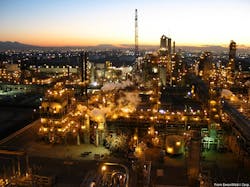ExxonMobil restarts Torrance refinery
ExxonMobil Corp. has restarted the fluid catalytic cracker (FCC) at its 155,000-b/d refinery in Torrance, Calif., after more than a year following a Feb. 15, 2015, explosion and ensuing fire shuttered the unit (OGJ Online, Feb. 19, 2015).
The FCC resumed operations on May 10 in compliance with a mandatory 6-hr, real-time continuous air monitoring period as ordered by California’s South Coast Air Quality Management District (SCAQMD), the regulatory agency responsible for air-pollution control for all of Orange County as well as portions of Los Angeles, Riverside, and San Bernardino counties, ExxonMobil said.
Based on the regulator’s determination that the FCC’s startup would result in higher emissions of particulate matter for about 6 hr longer than permissible under SCAQMD rules and the refinery’s Title V permit, the 6-hr heightened period of air monitoring was part of a series of conditions to which ExxonMobil agreed under SCAQMD’s Apr. 2 order for abatement consenting to the restart (OGJ Online, Apr. 4, 2016).
As part of SCAQMD’s approval, ExxonMobil also was to implement the following operational measures to mitigate excess emissions during the restart process:
· Reduce overall refinery throughput by about 25% to 100,000 b/d.
· Shut down two coker heaters.
· Operate all drift eliminator upgrades to the pretreater, hydrotreater, fuel gas treater, and north and south coker cooling towers.
Neither ExxonMobil nor SCAQMD have specified a definitive timeline for when the Torrance refinery—which has operated at about 20% of its rated capacity since the February 2015 explosion—will resume full operations.
To date, ExxonMobil has spent about $161 million to repair a damaged electrostatic precipitator—which controls fine particulate emissions from the FCC—as well as an additional $1.1 million on drift eliminator upgrades to the refinery’s pretreater, hydrotreater, fuel gas treater, and north and south coker cooling towers.
Torrance sale update
The pending restoration of the Torrance refinery to full-working order is a prerequisite to a deal ExxonMobil made in late 2015 for the sale of the refinery and related assets to PBF Holding Co. LLC, a subsidiary of PBF Energy Inc., Parsippany, NJ (OGJ Online, Oct. 1, 2015).
Alongside gaining all necessary regulatory approvals and restoration of refining operations to their full-working order prior to the February 2015 explosion, the Torrance refinery also must operate for at least 15 days without incident after such restoration, according to the proposed sale agreement.
Valued at about $537.5 million, the deal—which includes the Torrance manufacturing site as well as ExxonMobil’s related California product terminals, crude and product pipelines, and other logistics assets—originally was scheduled to close sometime during second-quarter 2016.
ExxonMobil still expects the transaction to close and PBF Energy to assume formal control of Torrance in mid-2016, said Jeff Woodbury, ExxonMobil’s vice-president of investor relations, said in the company’s latest quarterly earnings call on Apr. 29.
Contact Robert Brelsford at [email protected].

